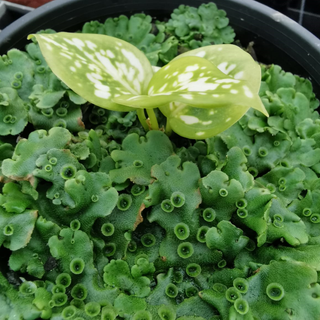Mosses, Liverworts, and Lichens at a Glance
| Feature | Mosses | Liverworts | Lichens |
|---|---|---|---|
| Appearance | Green, velvety mats or clumps | Flat, ribbon-like green patches | Crusty, leafy, or bushy textures in various colours |
| Hydrophilic/Aquaphobic | Hydrophilic: Thrive in damp environments; retain water | Hydrophilic: Require constant moisture for growth | Aquaphobic: Can tolerate extreme dryness but grow well in humid areas |
| Impact on Seedlings | Competes for water, reduces soil aeration | Blocks light and air from soil, slowing seedling emergence | Minimal direct impact but indicates excess humidity |
| Control Measures | Improve drainage, reduce overwatering | Increase airflow and soil drainage | Adjust growing conditions; rarely harmful |
| Interesting Fact | Can survive dehydration and regrow | Among the oldest land plants | A symbiosis of fungi and algae, thriving even in extreme environments |
What Do Hydrophilic and Aquaphobic Mean?
- Hydrophilic organisms, like mosses and liverworts, love water. They thrive in wet, moist environments, absorbing water from their surroundings to sustain themselves.
- Aquaphobic organisms, like lichens, are resistant to waterlogged conditions. They can survive in dry environments but are often found in areas with high humidity.
Understanding these terms is essential for managing conditions around your vegetable seedlings. Excessive moisture can encourage hydrophilic growth, while aquaphobic lichens may indicate other environmental imbalances.
Impacts on Vegetable Seedlings
1. Mosses: A Competitor for Resources
Mosses thrive in wet soil and can form dense carpets around seedlings. While they don’t directly harm your plants, they compete for water and nutrients, and their thick mats can reduce soil aeration. This can lead to stunted seedling growth, especially in seed trays or containers.
2. Liverworts: A Smothering Layer
Liverworts are even more moisture-loving than mosses. They form flat, green patches that can smother the soil surface, blocking light and air from reaching the roots and preventing seedlings from emerging properly. Their presence often signals poor drainage or overwatering.
3. Lichens: Harmless Yet Telling
Lichens, though aquaphobic, thrive in humid conditions and often appear on pots, rocks, or trees rather than soil. While they don’t harm seedlings directly, their growth might suggest overly damp or humid conditions that could eventually affect your young plants.
Managing Mosses, Liverworts, and Lichens
-
Improve Drainage
- Use a well-draining potting mix for seed trays and containers.
- Avoid water pooling by elevating pots and ensuring good drainage holes.
-
Adjust Watering Practices
- Water seedlings only when the topsoil feels dry to the touch.
- Water early in the day to allow surfaces to dry before evening.
-
Increase Airflow
- Space seedlings adequately to prevent overcrowding.
- Use a fan in greenhouses to improve ventilation and reduce humidity.
-
Manual Removal
- Gently scrape away moss or liverworts that have already grown around seedlings.
- Be cautious not to disturb fragile roots during removal.
-
Mulch Smartly
- A light layer of organic mulch can suppress moss and liverwort growth by keeping the soil surface drier while maintaining moisture below.
Balancing Benefits and Challenges
While mosses, liverworts, and lichens can be problematic in seedling beds, they also have benefits in the broader garden environment. Mosses and lichens, for example, can help retain moisture in surrounding areas and support biodiversity. However, in the delicate early stages of vegetable growth, managing these organisms is critical.
Conclusion: A Healthy Start for Your Seedlings
Understanding how mosses, liverworts, and lichens interact with their environment—and your seedlings—gives you the tools to create the ideal growing conditions. By controlling moisture, improving drainage, and maintaining airflow, you can strike the perfect balance between these fascinating organisms and your vegetable garden’s needs.
Keep your seedlings thriving by managing moisture levels and letting hydrophilic growth stay in its place—away from your vegetable trays!




